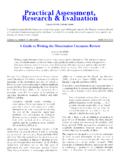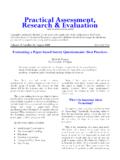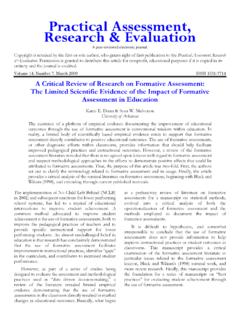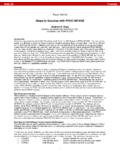Transcription of Volume 15, Number 12, October, 2010 ISSN 1531 …
1 A peer-reviewed electronic journal. Copyright is retained by the first or sole author, who grants right of first publication to the Practical Assessment, Research & Evaluation. Permission is granted to distribute this article for nonprofit, educational purposes if it is copied in its entirety and the journal is credited. Volume 15, Number 12, October, 2010 ISSN 1531-7714 Improving your data transformations: Applying the Box-Cox transformation Jason W. Osborne, North Carolina State University Many of us in the social sciences deal with data that do not conform to assumptions of normality and/or homoscedasticity/homogeneity of variance.
2 Some research has shown that parametric tests ( , multiple regression, ANOVA) can be robust to modest violations of these assumptions. Yet the reality is that almost all analyses (even nonparametric tests) benefit from improved the normality of variables, particularly where substantial non-normality is present. While many are familiar with select traditional transformations ( , square root, log, inverse) for improving normality, the Box-Cox transformation (Box & Cox, 1964) represents a family of power transformations that incorporates and extends the traditional options to help researchers easily find the optimal normalizing transformation for each variable.
3 As such, Box-Cox represents a potential best practice where normalizing data or equalizing variance is desired. This paper briefly presents an overview of traditional normalizing transformations and how Box-Cox incorporates, extends, and improves on these traditional approaches to normalizing data. Examples of applications are presented, and details of how to automate and use this technique in SPSS and SAS are included. Data transformations are commonly-used tools that can serve many functions in quantitative analysis of data, including improving normality of a distribution and equalizing variance to meet assumptions and improve effect sizes, thus constituting important aspects of data cleaning and preparing for your statistical analyses.
4 There are as many potential types of data transformations as there are mathematical functions. Some of the more commonly-discussed traditional transformations include: adding constants, square root, converting to logarithmic ( , base 10, natural log) scales, inverting and reflecting, and applying trigonometric transformations such as sine wave transformations. While there are many reasons to utilize transformations, the focus of this paper is on transformations that improve normality of data, as both parametric and nonparametric tests tend to benefit from normally distributed data ( , Zimmerman, 1994, 1995, 1998).
5 However, a cautionary note is in order. While transformations are important tools, they should be utilized thoughtfully as they fundamentally alter the nature of the variable, making the interpretation of the results somewhat more complex ( , instead of predicting student achievement test scores, you might be predicting the natural log of student achievement test scores). Thus, some authors suggest reversing the transformation once the analyses are done for reporting of means, standard deviations, graphing, etc.
6 This decision ultimately depends on the nature of the hypotheses and analyses, and is best left to the discretion of the researcher. Unfortunately for those with data that do not conform to the standard normal distribution, most statistical texts provide only cursory overview of best practices in transformation. Osborne (2002, 2008a) provides some detailed recommendations for utilizing traditional transformations ( , square root, log, inverse)
7 , such as anchoring the minimum value in a distribution at exactly , as the efficacy of some transformations are severely degraded as the minimum deviates above (and having values in a distribution Practical Assessment, Research & Evaluation, Vol 15, No 12 Page 2 Osborne, Applying Box-Cox less than can cause mathematical problems as well). Examples provided in this paper will revisit previous recommendations. The focus of this paper is streamlining and improving data normalization that should be part of a routine data cleaning process.
8 For those researchers who routinely clean their data, Box-Cox (Box & Cox, 1964; Sakia, 1992) provides a family of transformations that will optimally normalize a particular variable, eliminating the need to randomly try different transformations to determine the best option. Box and Cox (1964) originally envisioned this transformation as a panacea for simultaneously correcting normality, linearity, and homoscedasticity. While these transformations often improve all of these aspects of a distribution or analysis, Sakia (1992) and others have noted it does not always accomplish these challenging goals.
9 Why do we need data transformations? Many statistical procedures make two assumptions that are relevant to this topic: (a) an assumption that the variables (or their error terms, more technically) are normally distributed, and (b) an assumption of homoscedasticity or homogeneity of variance, meaning that the variance of the variable remains constant over the observed range of some other variable. In regression analyses this second assumption is that the variance around the regression line is constant across the entire observed range of data.
10 In ANOVA analyses, this assumption is that the variance in one cell is not significantly different from that of other cells. Most statistical software packages provide ways to test both assumptions. Significant violation of either assumption can increase your chances of committing either a Type I or II error (depending on the nature of the analysis and violation of the assumption). Yet few researchers test these assumptions, and fewer still report correcting for violation of these assumptions (Osborne, 2008b).












